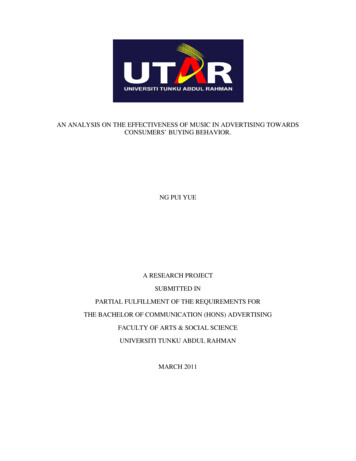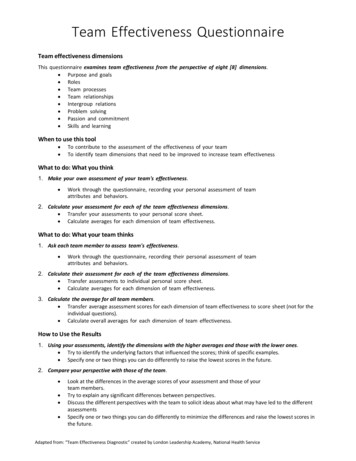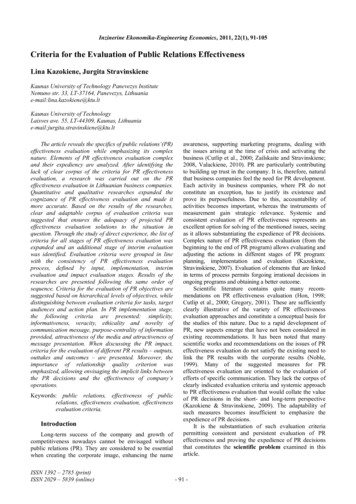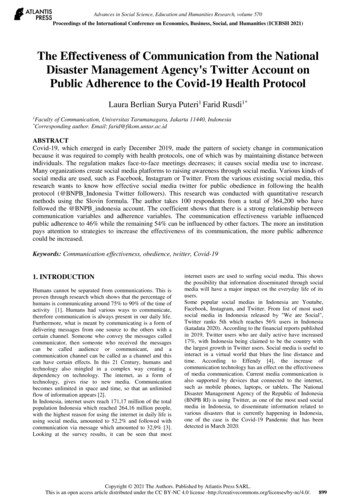
Transcription
AN ANALYSIS ON THE EFFECTIVENESS OF MUSIC IN ADVERTISING TOWARDSCONSUMERS’ BUYING BEHAVIOR.NG PUI YUEA RESEARCH PROJECTSUBMITTED INPARTIAL FULFILLMENT OF THE REQUIREMENTS FORTHE BACHELOR OF COMMUNICATION (HONS) ADVERTISINGFACULTY OF ARTS & SOCIAL SCIENCEUNIVERSITI TUNKU ABDUL RAHMANMARCH 2011
AN ANALYSIS ON THE EFFECTIVENESS OF MUSIC IN ADVERTISING TOWARDSCONSUMERS’ BUYING BEHAVIOR.NG PUI YUEA RESEARCH PROJECTSUBMITTED INPARTIAL FULFILLMENT OF THE REQUIREMENTS FORTHE BACHELOR OF COMMUNICATION (HONS) ADVERTISINGFACULTY OF ARTS & SOCIAL SCIENCEUNIVERSITI TUNKU ABDUL RAHMANMARCH 2011
ACKNOWLEDGEMENTThis dissertation would not have been possible without the guidance and help of severalgroups and individuals who in one way or another contributed and extended their valuablehelp and assistance in the preparation and completion of this study.First and foremost, my sincere thanks to my supervisor, Ms Tan Ser Zian forassisting and guiding me to get out of dead-ends at times, thanks for being patience wheneverI need help.Next, thanks a lot to my friends and family for their encouragement and help. Thanksfor being with me all the time and providing me everything to go on with the study. I amgrateful to them for pushing me keep on going, sharing their opinion and comments with me.Last but not least, I am thankful to my respondents for both questionnaires and indepth interview, thanks for spending their precious time for me in order to complete mysurvey. They have been very helpful to me.Thanks a lot to those I had missed out as well, their help and contribution incompleting my thesis are very much appreciated.NG PUI YUE
APPROVAL FORMThis research paper attached hereto, entitled “An Analysis on the Effectiveness of Music inAdvertising towards Consumers’ Buying Behavior.” prepared and submitted by” Ng Pui Yue”in partial fulfillment of the requirements for the Bachelor of Communication (Hons)Advertising is hereby accepted.SupervisorMs. Tan Ser ZianDate:
ABSTRACTMusic is one of the most important elements in all the mass electronic advertising.Advertisers pick the right song that can best suit the product and brand carefully in order toget positive feedback from the consumers. Inappropriate match of music in the advertisementwith the brand or product being advertised might lead to misinterpretation of the advertisingmessage and it can be distractive at times. The primary focus of this study is to find out ifmusic in advertising really effective towards the buying behavior of the students and youngworking adults.It is to develop a path model to explain how music works on the advertising and theeffectiveness measures including attitude toward the advertisement and the difference ofbuying behavior. One hundred sets of survey questionnaires were distributed concerning onthe effectiveness of music in advertising to youngster aged around eighteen to twenty-five.In-depth interviews were conducted in order to enhance the findings and also to get a moreaccurate result for this study. The result of this study will be able to reveal the impact ofmusic in advertising and how much it can affect the consumers. As the researchers did theresearch, it is proven that music in advertising is really important and it does affect onconsumers’ buying behavior. But however, the results from the research might not be fullyaccurate as the target audiences are only students of University Tunku Abdul Rahman andCollege Tunke Abdul Rahman with few random young working adults in Kuala Lumpur. Itcould not generalize the entire population of Malaysia. This research will be more accurate ifit was done with wider group of respondents of different ages and places.
DECLARATIONI declare that the material contained in this paper is the end result of my own work and thatdue acknowledgement has been given in the bibliography and references to ALL sources bethey printed, electronic or personal.The Word Count of this project is 10, 543 words.Name: NG PUI YUEStudent ID: 09AAB05918Signed:Date: 20th FEBRUARY 2011
TABLE OF CONTENTSPageABSTRACT .iDECLARATION .iiTABLE OF CONTENTS . .iiiLIST OF FIGURES vLIST OF TABLES .viCHAPTERSIIIINTRODUCTION .1Problem Statement . . .2Research Objectives . .3Research Questions . .4Hypothesis . 4Scope of Study . .4Methodology Framework . . 5LITERATURE REVIEWS . . .7Different Perceptions of Music. .7Roles Assigned to Music in Advertising . . .8Brand Differencing . . . .8Influent the Consumers . . . .8Cognitive or Affective Advertisement . . .9Various uses of Music in Advertising . . .10Entertain the Audiences . . . .10Create Continuity . . .11Increase Memorability . . .11Convey Message in a Non-Spoken Way 11Targeting .12Establish Authority . . .12Ways of Using Music in Advertising . .13Carry Verbal Message and Meaning 13Foreground Music 13“Elevator Music” .13
IIIIVVNo Music . 14The Effects of Emotional Responses to Music on Brand . 14Elements of Brand Communication . . 15Three “C” .16Link between Organization and Target Audience .17Impact of Music towards Consumers 17Jingles Effectiveness . . 17Impact of Background Music 18Theories .19Selective Retention 19Selective Exposure 20METHODOLOGY 22Research Methods .22Questionnaire Design .23Quantitative Research 23Qualitative Research .25FINDINGS & ANALYSIS .26Survey Questionnaire Analysis .26In-Depth Interview Analysis . 49DISCUSSION AND CONCLUSION . .54Attention Getting . . 54Mood Setter and Story Teller . 55Persuasive . . 56Targeting . 56Music builds brand recall and creates familiarity with a brand 57Memorability . . 58Great way to replace picture and words . .59Summary and Conclusion .59Limitations and Suggestions .60REFERENCES . .62APPENDICES66 .
LIST OF FIGURESFigurePage4.0Percentage of students and young working adults that pays attention tothe music or audio of advertisements . .294.1Perception towards advertisements with music . .314.2Music able to substitute picture and words in term of brand recall .334.3Reaction of students and young working adults after exposed toadvertisement with music . .344.4Advertisement becomes more persuasive for students and youngworking adults when their favorite songs of music was used as thebackground music in the advertisement . . 364.5Brand recall solely based on the music .374.6The ability to recall of students and young working adult on the jingleor music of the brand .384.7Students and young working adults' ability to remember and write outthe contact number of Pizza Hut correctly .404.8Reaction of the students and young working adults after exposed toPizza Hut’s advertisement .414.9The ability to remember and write out the contact number ofMcDonald correctly 434.10Reaction of the students and young working adults after exposed toMcDonald’s advertisement . .444.11The ability to remember the contact numbers if it was solely showedor being spoke in the advertisement 46
LIST OF TABLESTablePage4.0Number of respondents with their race and gender .264.1Age group of the respondents . 274.2Level of income or allowance of the respondents .284.3Perception towards advertisements with music .314.4Reaction of students and young working adults after exposed toadvertisement with music . .344.5The ability to recall of students and young working adults on thejingle of music of the brand . 384.6Reaction of students and young working adults after exposed to PizzaHut’s advertisement . .414.7Reaction of students and young working adults after exposed toMcDonald’s advertisement . .444.8Ranking of different statements based on music in advertising .48
CHAPTER IINTRODUCTION1.1History of MusicTracing back the history of music, music had a very long, complex and captivating history.Its emergence could predate language, and most certainly predates the written words. Thedevelopment of music occurred against the backdrop of natural sounds like the lapping ofocean waves, the rippling of water, the singing of birds, sounds created by other animals andso forth. Prehistoric music which is the most ancient music was given to all music producedby preliterate cultures that began somewhere in the late geographical history. This period wasended with the creation of writing (Music Archive, 2009).The eras of music history started with the Middle Ages, followed by the Renaissance,Baroque Age, Classical Period, Romantic Era and lastly, the Twentieth Century (Sherrane. R,2009).1.2 How can music adapted to AdvertisingHistorically, advertising was first introduced in print media. Early newspaper was filled withnews text contains only words but nothing else. Advertising came in later on and benefitsboth subscribers and advertisers. (David Huron, 1989)But how can music is adapted to advertising? Well, advertisements in print media likenewspapers and magazines are definitely not accompanied by sound, but music appears in allmass electronic media nowadays.
Music in advertising which used in electronic medias like television advertisements,radio advertisements, cinema advertisements and so forth are divided into two different formswhich is background music and jingles. Background music defined as live or recorded musicplayed behind the spoken dialogue or announcements to establish mood or to influence theemotional impact of a scene in the broadcast production. It comes without lyrics and alsowith lyrics sometimes. However jingles are tunes with lyrics written for specific productadvertising, and are broadcast on television and radio. The music is usually original(Rutherford. P, 2006).In this day and age, almost each and every advertisement in mass electronic mediawas accompanied by music, either jingles, or the score, which is commonly known as thebackground music or both. Advertisements without music are dull and unattractive. Ascompetition is getting more and more stronger, advertisers putting more efforts in each andevery aspect of an advertisement to make sure it stand out among the competitors and get theattention on their targeted target market. It is important to choose suitable background musicor to create unique and easily recognizable jingles to catch the consumers’ attention.Appropriate use of music in advertising can actually helps to deliver a message better, helpsto persuade the consumers to purchase the product or service and even helps to build brandrecall and brand recognition.1.3 Statement of ProblemAdvertisers scratched their head in order to choose the right music to suit the productadvertised, the target market, and also the brand. Different target market of different
demographic groups’ preferences of music can be different. Moreover, different peopleperceive music differently.Although most commercials use music, but music might be distractive in the processof message processing. Inappropriate use of music might cause misinterpretation of themessage in an advertisement. Besides, listeners sometimes attend to the music so closely andthe message might not be processed.Advertisers nowadays spend large amount of money on the production of each andsingle advertisement with music. Creative fees for an original composition can cost more thantwo million ringgit Malaysia (Karmen, 1989). To use famous songs in the advertisement willcost much more.Industry is taking great risk by spending millions of dollars on the belief that musichelps advertisements sell and create better awareness. However, is it really worth to spendthat much on using music in an advertisement?1.4 Research ObjectivesThe specific objectives of this study are To find out the differences between advertisements with music and advertisementswithout music To investigate how does music influence consumers’ attitude or buying behavior To find out if music will affect in brand recognition
1.5 Research QuestionsThe research question for this study are listed as followed, What is the difference between advertisements with music and advertisements withoutmusic How does music influence consumers’ attitude or buying behavior. How does music helps to build brand recognition.1.6 HypothesisThe hypotheses of this study are, Advertisements with music will gain more attention and is more memorablecompared to advertisements without music As music with advertisements will grab the attention of the consumers’, it willultimately persuade them to purchase the advertised product. Advertisements with music are more effective in the transmission the message by theadvertiser thus helping to build better brand recognition.1.7 Scope of StudyThis study focuses on the students and young working adults. A total of one hundred sets ofsurvey questionnaires will be distributed to students of Kolej Tunku Abdul Rahman PerakCampus, thirty sets, Universiti Tunku Abdul Rahman Perak Campus, fifty sets and workingadults in Kuala Lumpur, twenty sets. The main reason this target audience is chosen is due to
the age group which is eighteen to twenty-five years old because people of this age will tendto have stronger preference on certain genres of music. Different taste of music will enablethem to differentiate different genre of music and they will pay more attention based on thegenre on music that they prefer. Another reason for this convenience sampling is because ofthe time and budget constrain. Target audience of the stated are more easily accessiblecompared to other target audience. The survey questionnaires will be distributed in forms ofonline and offline, which is fifty sets each. This was decided because it enables the researcherto distribute a larger amount of questionnaire in a shorter amount of time.On top of that, in-depth interviews will be conducted to strengthen the resultstabulated from the questionnaire. Ten respondents will be selected to be asked few questionsin order to get more in depth opinions and viewpoints. They are students from UniversityTunku Abdul Rahamn and aged around eighteen to twenty five as well. Each of them will beasked ten different open ended questions. Four different videos will be shown to help guidethem in the answering of the questions.1.8 Methodology FrameworkTo gain a precise and accurate result for this study, both qualitative and quantitativeresearch will be conducted. The core method in conducting this research will be surveyquestionnaire when a total of one hundred sets of questionnaire will be distributed torespondents aged around eighteen to twenty-five. This age group of respondents was selectedbecause people of this age will tend to have stronger preference on certain genres of music.The main purpose to use survey questionnaire in this study is to gain statistic and data innumbers as it will be way easier to analyze. The questionnaire will introduce questions to
testify various viewpoints of the respondent regarding the use of music in advertisement andits influences towards their buying behavior.On top of that, ten respondents aged around eighteen to twenty-five will be selectedfor an in-depth interview in order to get more details answers on what triggers the students topurchase the product. Whether the music able to build better brand recognition and the genresable to get their attention to urge them to purchase the products. All information gainedduring the interview will be remarked, further results will be shown in findings.
CHAPTER IILITERATURE REVIEW2.1 Different Perceptions of Music.Some people might thinks that music is something huge, something complex, and evensomething that connects peoples and cultures around the world. Some people always thoughtof music as a universal language, even the listeners do not understand the lyrics, but themelody might able to make them understand the song and feel the emotions. But some peoplemight describes music as noise, noise that sounds good and but may be distracting sometimes,and it could be noise that crafted in a way that can stirs the listeners’ soul. Some people evendefined music as a story, a mixture of how the artists feel and also the experiences the artistshad and messages they want to convey.Definition of music varies with the cultural differences, for instance, Ancient Indianand Greek philosophers defined music as tones ordered horizontally as melodies andvertically as harmonies. However, the twentieth century composer John Cage explainedmusic as any form of noise- “There is no noise, but only sound”. On the other hand,Musicologist Jean-Jacques Nattiez said that “The border between music and noise is alwaysculturally defines, there is rarely a consensus on the definition between both. (James Pritchett,2009)In short, there is no single and intercultural universal concept defining on what musicis. It highly depends on individuals based on their cultural background, education background,thinking, and so forth. Everyone have different perceptions towards music, some of thepeople might like music a lot but some of them might think that music is just a distraction.
Besides, there is no right or wrong way of defining the music; it is something huge andabstract.2.2 Roles Assigned to Music in Advertising“Music composed with the purpose of selling consumer goods and services make up a fairproportion of the songs, jingles, and melodies encountered by the public on a daily basis”.We are exposed to tonnes of music that is crafted with the purpose of supporting sales everysingle day whenever we shops in the shopping malls and hypermarkets, listen to the radio,watch television and even when we surf the Internet. (Jantzen and Graakjaer, 2009)2.2.1 Brand DifferencingAccording to a research done by Stewart and Furse (1986), they found out that the mostimportant factor for building advertising recall and persuasion is to build a branddifferentiating message. On top of that, purchase intent was higher with advertisements thathad music in it, and generally, subjects had more negative attitudes towards advertisementswithout music.2.2.2 Influent the ConsumersAccording to the study by Stout and Leckenby (1988) on the relationship of emotional andcognitive viewer response to specific musical variables, they found out that music inadvertisement can actually influence the information retrieved by consumers and also, thepurchase intention of the consumers was higher with the advertisement with music in it.
2.2.3 Cognitive or Affective AdvertisementThe effectiveness of music in an advertisement depends on whether the advertisement is toserve as cognitive or affective purpose. The target market and communication goal is alsoimportant to fit the advertisement with the music used. If the music was assigned to serve adominant role where it will be noticed, be distinctive, and used in the foreground, it will morelikely to be part of an affect-based advertisement. On the other hand, if the music was used inthe background and less attention getting which is to carry a less dominant role, theadvertisement will be more of cognitive-based (Alpert et al., 1991).Since many advertisements have combination of both cognitive and affectivecomponents, with the degree of emphasis on one or another, the role of music might need tobe relevant with this degree of emphasis in the advertisement. In a nutshell, the moreimportant the role music has in an advertisement, the more affect-based the advertisement islikely to be, the less significant the role music has, the more cognitive-based theadvertisement will be (Alpert et al., 1991).There are few different viewpoints from different scholars where the viewpoint ofJantzen and Graakjaer (2009) is almost similar with Stewart and Furse’s (1988) opinion.According to these scholars, music is used everywhere and it is extremely important inadvertising. The two forms of music in advertisements which is jingle and background musicare used in most of the mass electronic media and it actually playing the role which is topersuade the audiences, urge them to purchase or get more information about the product orbrand advertised. It also differentiates brands with the competitors. Besides that, using musicin mass electronic advertisements had already become a norm; people will feel weird andboring if there is advertisement that created without using any music.
However scholars Stout and Leckenby (1988) and Alpert et al. (1991) said that therole of music varied according to how the advertisers place it. Some music was used in theforeground and some was used in the background, and it is highly depends on the role thatthey are playing in an advertisement, whether it is important or not. There are two importantroles of music in advertisement, which is to influence the information retrieved by theconsumers or to affect the emotions of them.2.3 Various Uses of Music in Advertising.2.3.1 Entertain the AudiencesMusic plays an important role to entertain the audiences; a good music can make anadvertisement more lively and attractive and directly making it an effective piece ofcommercial. Good advertisements served to engage listeners' attention and render theadvertisement less of an unwanted intrusion, the most straightforward way of achieving thisis to create an appeal which is entertaining. The music need not necessarily manifest anyspecial affinity with a particular product or service in order to play an effective and usefulfunction. (David Huron, 1989).2.3.2 Create ContinuityMusic also employed in various structural roles and served as the function of continuity. Itwas always tied together with a sequence of visual images, narrative voice-over or a list ifproduct appeals. The second structural function is the use of music to highlights the dramaticmoments (David Huron, 1989).
2.3.3 Increase MemorabilityMusic is also important to increase the memorability of a product or the product’s name.Consumers will normally choose those products which obtain some degree of recognition orfamiliarity, even if it’s just the product’s name. With the association of music along with theidentity of certain product may helps to create product recall. Jingle is one of the mostcommon and effective musical technique for aiding memorability of its products and brand.(David Huron, 1989)2.3.4 Convey Message in a Non-Spoken WayOn top of that, vocal music enables the conveyance of verbal message in a non-spoken way.Mixture of speech and song provide advertisers with opportunities for both logical, factualappeals and emotive, poetic appeals. It is easy to recognize which passages of an ad copy areintended to be spoken and which passages are intended to be sung. Also, musical lyrics areuseful as an authoritative frame. Statements which are sung elicit less critical reflection thanspoken statements. (David Huron, 1989)2.3.5 TargetingMusic is a great way for targeting according to David Huron (1989) as well; musical stylesare always identified with various social and demographic groups. Therefore, it always assistsin targeting a specific market. It also functioned as a socioeconomic identifier which is adevice for addressing a specific audience.
2.3.6 Establish AuthorityClosely related to the targeting function is the use of music to enhance an advertisement’scredibility, to establish its authority. The so-called musical "hook" is just a species of jingle,oriented toward the achievement of the same purpose: increasing memorability and productrecall. Through quotation, reference, or plagiarism, musical gestures such as riffs,instrumental timbres, rhythms, and so forth are used both to target audiences and to establishmusical authority. (David Huron, 1989)With music, it will be way easier to communicate. It is faster and more effective.Some of us hum tunes that come with advertisement. People always said that music able toappeal to our right brain and create resonance; and this resonance is important as it can stickthe brand name in the mind of listeners. In advertisement, music primarily carries the entiremessage and meaning. It not only reinforce brand message and enhances brand recall for aproduct of an advertisement through an evoked image, but it may also evoke feelings, mood,emotions and even behaviors.2.4 Ways of Using Music in Advertising.2.4.1 Carry Verbal Message and MeaningMusic with lyrics can be use in advertisements to carry the advertisement’s verbal messageand meaning. It can provide an atmosphere, create an image, set a mood, and eveninfluencing affect throughout the advertisement. (Judy I. Alpert and Mark I. Alpert, 1991)
2.4.2 Foreground MusicMusic with lyrics that do not carry the advertisement’s message directly was commonly usedin the commercial nowadays as well. In these advertisements, the words are not about theproduct and it is not contributing to the mood or atmosphere, but the music is in theforeground throughout the advertisement, and is the primary form of communication. Besidesthat, there are advertisements which use only instrumental or electrical music without lyrics isin the foreground, there is almost no voice-over, and the verbal message is brief and inwritten form. (Judy I. Alpert and Mark I. Alpert, 1991)2.4.3 “Elevator Music”According to Judy I. Alpert and Mark I. Alpert (1991), in some of the advertisements, musicis used only in the background, quietly and not distinctive generally, it resembles “elevatormusic”, and the voice over continues throughout the advertisement. Besides, music can beused to emphasize a phrase as in a key brand attribute, or logo in an advertisement. Themusic background normally lasts for the duration of the phrase they wish to emphasize on.(Judy I. Alpert and Mark I. Alpert, 1991)2.4.4 No MusicThere are also advertisements that do not use music at all, in these advertisements, narratorswill be fully utilize throughout the whole advertisement and this kind of advertisements areusually more formal. (Judy I. Alpert and Mark I. Alpert, 1991)
There is no right or wrong ways of using music in an advertisement. But the musicused should always suit the whole advertisement, the product or the brand well in order tostay away from any misinterpretation. Sometimes, even just a simple piece of music canmake an advertisement attractive and memorable.2.5 The Effect of Emotional Responses to Music on BrandFamiliarity and liking of the music actually brings a great influence on the effectiveness ofthe music in advertising. Some consumers like the advertisement because the music usedbring forth pleasant thoughts and associations, memories, and imagery to the particularconsumer, or may be the consumer like the melody, rhythm and genre of the music and soforth. The singers or composers of the music may also bring great influence on affecting theliking of the music and directly affect the consumer behavior towards the product beingadvertised. However the preference of the music is perceived depends on the complexinteraction of internal (biological) and external (social, cultural influences) factors which alsoaffect when and how musical taste is developed (Alpert & Alpert, 1991).According to Stout and Leckenby (1988), the information retrieved by consumersfrom the advertisements was highly related with the liking of the music used as well. If theconsumer like the music used in the advertisement, they will definitely pay more attentionwhen they exposed to the advertisement and they will surely able to retrieve moreinformation from the advertisement (Alpert & Alpert, 1991).Therefore, in my opinion, advertisers need to be careful in selecting an appropriatemusic that can gain more attention of their target market. Advertisers need to understand thetarget markets’ demographic as well as the music they want to use in an advertisement well.
They can actually predict with some accuracy on their musical preference and taste of thetarget market with their demographic profile. Besides, they also need to study about themusic that they planning to use in an advertisement, to make sure it is not against the musicpreference of the target market.2.6 Elements of Brand CommunicationBrand communication defined as the process of the interaction between a corporation and themarketplace. If the brand communication is delivered effectively, a company gets to expresswhat it stands for and the special value proposition. Brand communication covers publicrelations, advertising, and even investor relations. Effective brand communication enables thecompany to achieve its business objectives (Byrum. K, 2010).2.6.1 Three “C”According to S
the effectiveness of music in advertising to youngster aged around eighteen to twenty-five. . advertising, and are broadcast on television and radio. The music is usually original (Rutherford. P, 2006). In this day and age, almost each and every advertisement in mass electronic media was accompanied by music, either jingles, or the score .











